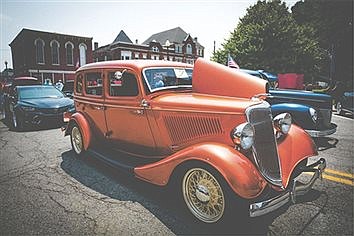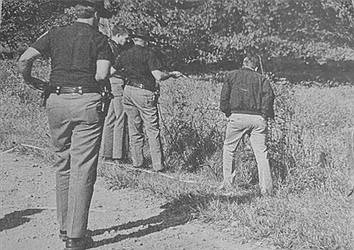Route 1 residents skeptical of corridor plans
February 8, 2023 at 8:18 p.m.
If property owners in the largely agricultural region surrounding St. Leon have their say, plans to develop the State Road 1 corridor from roughly Hyland Road in Dearborn County to the Brackney Development LLC site in Franklin County will be as slow as a turtle seeking to cross Southgate Hill.
At an informal kickoff presentation hosted at East Central High School last Tuesday, Cory Whitesell and Adam Peaper of HWC Engineering, Indianapolis, spoke briefly to a gathering of about 50 residents to lay the groundwork for the long-term State Road 1 Corridor Plan that is currently in its infancy.
A few landowners strongly voiced concerns about the project, recalling similar battles over the last couple decades and cautioning against the area becoming another Boone County and Eastgate, Kentucky, or Colerain Avenue and West Chester, Ohio.
Mark Hall of Hall Farms, Sunman, said his family has farmed in the area for over 70 years.
“Farms come up for sale, they’re turned into subdivisions,” he said. “You go all around (I-275), you see big box warehouses and industry. For me, that’s not the kind of place I want to live. This is our little heaven here, this part of the county. My opinion, we need to talk about slow … things that fit into our community.”
Whitesell responded, saying “a challenge when you say no or slow development, but what happens if (local) ordinances make it easy to subdivide five acres – or smaller than 20 acres – and so, little by little, you accomplish protection by concentrating development to a smaller area.
“So how do you find those balances? Where is development appropriate? What should it look like?”
Another resident said while planning and public input may all look good, ultimately development will happen whether people want it or not. She cited a friend near Florence, who was against development that eventually took place.
Whitesell didn’t wholly agree with that, stating the public does have a right to say what does and doesn’t come to the area. He said the beautiful part of the process was “the future is out there to define.”
Hall added that he was involved in no fewer than 15 different would-be disputes over the past 20 years – i.e., Outer Loop Highway, industrial farms and airport at Lawrenceville, NW Quadrant, multiple subdivision proposals – and of those, only the subdivision off Dogwood Court directly south of ECHS came to fruition.
“Don’t feel like it’s going to happen or they’re going to steamroll over the citizens, voters, taxpayers of the county,” he said. “When the time comes to get together, we’ll get together.”
Hall said he had once served on the governor’s committee for farmland preservation, but beyond that, the committee spoke about smart growth. That could be defined as radiating out from an urban area like Lawrenceburg or Harrison, Ohio, not jumping out to St. Leon. “People are coming out here to try to get away from that,” he said.
Zoning came up frequently at the discussion, as a property owner’s rezone to commercial/industrial is said to have triggered renewed interest in the area. Peaper explained there are multiple jurisdictions in play.
“If a property is in St. Leon, that’s St. Leon Plan Commission and town council making the decision,” he said. “If it’s in unincorporated Dearborn or Franklin counties, it’s county plan commissions and county commissioners.
“Say, if someone applied for a rezone to multi-family apartments in an area where they’re not appropriate, you’d hope the board would say no,” he added.
Another resident raised concerns about increased taxes due to things like revamped infrastructure (utilities, sewage). She was aggravated this was happening again, because she and others fought it several years ago.
While touting the corridor’s easy access to I-74 and quality schools as attractive factors for developers, Whitesell acknowledged that it didn’t seem to be a popular option among Tuesday’s crowd; but, he said, at some point one person did want to sell and that leads to what’s being studied.
Map exercises
There were a few stations set up to get some initial input on items: vicinity of residents’ homes; placemaking efforts to improve the region; types of industrial/residential/commercial development; community visioning/big ideas; assets/opportunities; issues/challenges; appropriate development/building types; quality of place amenities; and future land use.
The largest clusters of stickers placed by attendees came when discouraging warehouses, major manufacturing, convenience and regional retail, one-family subdivisions (small or large lots) and encouraging agricultural preservation, improvement of traffic/safety and roadway improvements. In the next tier were heavy discouragement of restaurants/fast food, light industrial/small scale manufacturing, apartments, professional services and office buildings and mediocre support for expanding broadband. A few were in favor of bicycle/pedestrian infrastructure, commercial health/wellness, new parks, agribusiness and rural estates.
Background/future
Peaper provided some recent history on how the study came about.
“A big goal is to retain and attract people and investment in the community,” he said. “Population has kind of been stagnant across southeast Indiana, but this is one of the few places it’s growing. In understanding that, we’re trying to proactively help Dearborn and Franklin counties’ plan for potential development.
“What can the land support, what do you all as a community support, and what is the market going to support?” he proceeded.
Peaper confirmed there are properties in the area currently being marketed for residential and industrial development. The study is funded by federal American Rescue Plan Act monies funneled through the state’s Regional Economic Acceleration and Development Initiative (READI), with local county contributions.
“Our charge is to see if there’s an opportunity for investment that can enhance quality of life while also preserving all of the already great things in Dearborn and Franklin counties,” he said.
The study area is actually a T-shaped swath that juts slightly east of the SR 46/1 interchange, then extends west over to Lawrenceville Road. Peaper said this may be scaled back in the future.
All compiled results – from Tuesday’s input and online survey (www.surveymonkey.com/r/SR1_public_input) – will go back to the project steering committee that consists of John Palmer and Bill Schirmer of Franklin County and Mike Perleberg and Gage Pace of Dearborn, as well as Dearborn Co.’s area plan director and business owner David Deddens. The committee’s analysis will lead to preliminary recommendations ahead of an open house targeted for April, followed by a rough draft in late spring and a public draft this summer to be presented to the Southeast Indiana READI group.
“It’s about developing the toolkit and informing elected and appointed leaders as they make these development decisions in the future,” said Peaper. “What are potential impacts and costs to serve that development with infrastructure?”
“One way or another, it's going to look very different 20 years from today,” added Whitesell. “So how do you manage that? It’s about the community coming up with a consensus plan.”
All project documents and updates can be followed at www.sr1corridorplan.comLatest News
E-Editions
Events
If property owners in the largely agricultural region surrounding St. Leon have their say, plans to develop the State Road 1 corridor from roughly Hyland Road in Dearborn County to the Brackney Development LLC site in Franklin County will be as slow as a turtle seeking to cross Southgate Hill.
At an informal kickoff presentation hosted at East Central High School last Tuesday, Cory Whitesell and Adam Peaper of HWC Engineering, Indianapolis, spoke briefly to a gathering of about 50 residents to lay the groundwork for the long-term State Road 1 Corridor Plan that is currently in its infancy.
A few landowners strongly voiced concerns about the project, recalling similar battles over the last couple decades and cautioning against the area becoming another Boone County and Eastgate, Kentucky, or Colerain Avenue and West Chester, Ohio.
Mark Hall of Hall Farms, Sunman, said his family has farmed in the area for over 70 years.
“Farms come up for sale, they’re turned into subdivisions,” he said. “You go all around (I-275), you see big box warehouses and industry. For me, that’s not the kind of place I want to live. This is our little heaven here, this part of the county. My opinion, we need to talk about slow … things that fit into our community.”
Whitesell responded, saying “a challenge when you say no or slow development, but what happens if (local) ordinances make it easy to subdivide five acres – or smaller than 20 acres – and so, little by little, you accomplish protection by concentrating development to a smaller area.
“So how do you find those balances? Where is development appropriate? What should it look like?”
Another resident said while planning and public input may all look good, ultimately development will happen whether people want it or not. She cited a friend near Florence, who was against development that eventually took place.
Whitesell didn’t wholly agree with that, stating the public does have a right to say what does and doesn’t come to the area. He said the beautiful part of the process was “the future is out there to define.”
Hall added that he was involved in no fewer than 15 different would-be disputes over the past 20 years – i.e., Outer Loop Highway, industrial farms and airport at Lawrenceville, NW Quadrant, multiple subdivision proposals – and of those, only the subdivision off Dogwood Court directly south of ECHS came to fruition.
“Don’t feel like it’s going to happen or they’re going to steamroll over the citizens, voters, taxpayers of the county,” he said. “When the time comes to get together, we’ll get together.”
Hall said he had once served on the governor’s committee for farmland preservation, but beyond that, the committee spoke about smart growth. That could be defined as radiating out from an urban area like Lawrenceburg or Harrison, Ohio, not jumping out to St. Leon. “People are coming out here to try to get away from that,” he said.
Zoning came up frequently at the discussion, as a property owner’s rezone to commercial/industrial is said to have triggered renewed interest in the area. Peaper explained there are multiple jurisdictions in play.
“If a property is in St. Leon, that’s St. Leon Plan Commission and town council making the decision,” he said. “If it’s in unincorporated Dearborn or Franklin counties, it’s county plan commissions and county commissioners.
“Say, if someone applied for a rezone to multi-family apartments in an area where they’re not appropriate, you’d hope the board would say no,” he added.
Another resident raised concerns about increased taxes due to things like revamped infrastructure (utilities, sewage). She was aggravated this was happening again, because she and others fought it several years ago.
While touting the corridor’s easy access to I-74 and quality schools as attractive factors for developers, Whitesell acknowledged that it didn’t seem to be a popular option among Tuesday’s crowd; but, he said, at some point one person did want to sell and that leads to what’s being studied.
Map exercises
There were a few stations set up to get some initial input on items: vicinity of residents’ homes; placemaking efforts to improve the region; types of industrial/residential/commercial development; community visioning/big ideas; assets/opportunities; issues/challenges; appropriate development/building types; quality of place amenities; and future land use.
The largest clusters of stickers placed by attendees came when discouraging warehouses, major manufacturing, convenience and regional retail, one-family subdivisions (small or large lots) and encouraging agricultural preservation, improvement of traffic/safety and roadway improvements. In the next tier were heavy discouragement of restaurants/fast food, light industrial/small scale manufacturing, apartments, professional services and office buildings and mediocre support for expanding broadband. A few were in favor of bicycle/pedestrian infrastructure, commercial health/wellness, new parks, agribusiness and rural estates.
Background/future
Peaper provided some recent history on how the study came about.
“A big goal is to retain and attract people and investment in the community,” he said. “Population has kind of been stagnant across southeast Indiana, but this is one of the few places it’s growing. In understanding that, we’re trying to proactively help Dearborn and Franklin counties’ plan for potential development.
“What can the land support, what do you all as a community support, and what is the market going to support?” he proceeded.
Peaper confirmed there are properties in the area currently being marketed for residential and industrial development. The study is funded by federal American Rescue Plan Act monies funneled through the state’s Regional Economic Acceleration and Development Initiative (READI), with local county contributions.
“Our charge is to see if there’s an opportunity for investment that can enhance quality of life while also preserving all of the already great things in Dearborn and Franklin counties,” he said.
The study area is actually a T-shaped swath that juts slightly east of the SR 46/1 interchange, then extends west over to Lawrenceville Road. Peaper said this may be scaled back in the future.
All compiled results – from Tuesday’s input and online survey (www.surveymonkey.com/r/SR1_public_input) – will go back to the project steering committee that consists of John Palmer and Bill Schirmer of Franklin County and Mike Perleberg and Gage Pace of Dearborn, as well as Dearborn Co.’s area plan director and business owner David Deddens. The committee’s analysis will lead to preliminary recommendations ahead of an open house targeted for April, followed by a rough draft in late spring and a public draft this summer to be presented to the Southeast Indiana READI group.
“It’s about developing the toolkit and informing elected and appointed leaders as they make these development decisions in the future,” said Peaper. “What are potential impacts and costs to serve that development with infrastructure?”
“One way or another, it's going to look very different 20 years from today,” added Whitesell. “So how do you manage that? It’s about the community coming up with a consensus plan.”
All project documents and updates can be followed at www.sr1corridorplan.com




